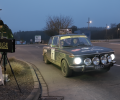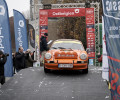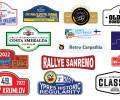THRR - Introduction to FIA Historic Regularity Rally
The final of the 2022 FIA Trophy for Historic Regularity Rallies will be hosted by the Ostbelgien Classic on the 02-04 December 2022. The rally is based in the city of Eupen, which is the capital of the German speaking community of Belgium, less than 10km from the border with Germany and close to the Netherlands and Luxembourg in the east of the country.

The Ostbelgien Classic has a route length of approximately 800 km divided into three legs. The route will include regularity tests on roads open to public traffic where the competitors will aim to keep an average speed of 50kph.
What is a Regularity Rally?
The purpose of a Regularity Section on a Historic Road Rally is to test the crew's skill at maintaining a precise average speed over a defined route, usually on public roads.
Each regularity section will have a Start Control, several Intermediate Time Controls that are mostly kept secret and a Finish Point. The aim is to take the correct amount of time between each consecutive pair of timing controls. Being early or late at one control must usually be carried over and not made up, so at each intermediate control you can forget about your timing over the previous section and start again from scratch for the new section.
The average speed the FIA Trophy for Historic Regularity Rallies is a maximum of 50kph.
With the emphasis on precision and accuracy over speed means the costs of preparing and running the cars in a Regularity Rally is much cheaper than cars running in a closed road rally, where the emphasis is on speed and the regulations are in place to make the cars and participants as safe as possible. On a regularity rally there is no requirement for FIA homologated safety harnesses, roll cages and the use of helmets and fireproofs, though helmets will be required on the Ostbelgien Classic when the cars take to the Spa-Francorchamps circuit.
Many of the crews taking part in a Regularity Rally are from the same family, such last year’s winners, father and daughter team Stanislaw and Anna Postawka.
Points Scoring
The ideal scoring time is the sole responsibility of the crews who can view the official watch placed on the control table, but the officials cannot give them any information about this ideal scoring time.
Any difference between the actual time and the ideal scoring time will be penalised with -
- For any delay: 60 points per minute (TC) or 1 point per second (TCS);
- For any advance: 120 points per minute (TC) or 2 points per second (TCS);
- Absence of a time control visa or arrival at the control after the maximum time allowed: 900 points per control;
- Maximum time allowed without flat penalty at time controls: 15 minutes per LEG (day).
Who is Eligible to Compete for the FIA Trophy for Historic Regularity Rallies?
The format for the FIA Trophy for Historic Regularity Rallies consists of national events, which are recognised as "qualifying events", and the Final, which is the Ostbelgien Classic, at which the FIA Trophy will be awarded.
Drivers and co-drivers who participated in at least one qualifying event and who finished in the top 33% of the general classification will therefore be eligible to compete in the Final and claim the FIA title.
The cars will be divided into 7 age groups according to the FIA periods based on the date of the first homologation:
- Category A > E: up to 1961
- Category F : from 1962 to 1965
- Category G : from 1966 to 1971
- Category H : from 1972 to 1976
- Category I : from 1977 to 1981
- Category J1 : from 1982 to 1985
- Category J2 : from 1986 to 1990
Information
For more information on the Ostbelgien Classic visit the official website HERE.
Image Courtesy of www.ostbelgian-classic.be / Xact Production

 Facebook
Facebook Twitter
Twitter






